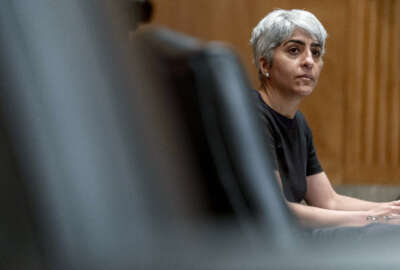For OPM’s Ahuja, rebuilding the federal workforce takes on many forms
Rebuilding the federal workforce -- and the Office of Personnel Management itself -- is the top priority for the agency's new director, Kiran Ahuja.
Rebuilding is the name of the game for Kiran Ahuja, the new director of the Office of Personnel Management.
It’s a big goal for both the federal workforce and OPM itself, said Ahuja, who in many ways sees her presence — and her commitment to the agency — as the key to attaining real progress that has often been difficult to realize across many administrations.
“I made the commitment during my confirmation process. I’ve said it a number of times to my colleagues at OPM that my plan is to be here for as long as people will have me,” Ahuja told reporters Wednesday morning during her first engagement with the press. “I know that’s contingent on lots of different folks, but my commitment is to be here for the long haul.”
OPM hasn’t had a permanent director for much of the last year, and it’s seen a revolving door of acting leaders since 2015. The National Academy of Public Administration flagged leadership turnover as a critical challenge for OPM, particularly if it wants to make progress on a long agenda for the federal workforce.
Rebuilding the federal workforce is a top priority for Ahuja, who said agencies across government have lost talent in recent years, including at OPM.
For Ahuja, “rebuilding” means attracting young talent to government and creating a better pipeline for them to succeed throughout their careers. It means creating a federal workforce that looks like the rest of the country — and one that feels supported to do their work.
“What I consider incredibly important from my role is that every single day when I wake up, I am thinking about the morale of this workforce, and I am putting that front and center,” she said.
And it means reestablishing the federal government as a model employer, one that prioritizes pay equity, work-life balance and partnership with federal unions.
“We have this rich history of the federal government providing a pathway to the middle class. We can build on that,” Ahuja said.
Agencies are knee-deep in reimagining their telework, remote work and other workplace flexibilities based on their experiences during the pandemic. Ahuja said the Biden administration will expand on that work.
“That [means] looking at the whole set of benefits that come with employment,” she said. “Again, it’s not just salary. Workers are attracted to their jobs for many reasons, and so we’re thinking about the whole package, from child care to competitive health and retirement benefits.”
Past OPM directors have announced ambitious legislative agendas, intending to tackle everything from veterans preference to the General Schedule.
Ahuja said she’ll push a mixed agenda of both regulatory and legislative changes. In the short-term, she’s focused on the regulatory space — providing agencies with technical and policy guidance that they need to support future of work policies.
“We do want to have a legislative agenda,” she said. “I, in my somewhat lengthy confirmation process, had a lot of time to engage with folks on the Hill. There’s real interest in having a partnership, and we’re also trying to rebuild that relationship with all of them.”
Ahuja didn’t shy away from the criticism OPM has received over the years. Agencies can’t rebuild their workforces without a strong and independent OPM, she said.
“What’s going to be really critical to all of this… is to ensure that this agency is positioned as the strategic human capital leader across the federal government,” Ahuja said. “There is no way in the world, in my opinion, of all the things that we need to achieve to serve the American people, if we do not ensure that we have the right people in the right positions. More than ever we have realized that people are our biggest asset. We are going to ride that wave that exists right now and really position OPM in a way that we can be of great support and partnership with our partner agencies.”
Inside OPM, Ahuja said she’ll soon host listening sessions with employees, and the agency is focused on its own hiring needs. OPM has lost “a bit of institutional knowledge,” in recent years, she acknowledged.
“I’m very well aware that the lack of capacity in people having to work much more to cover two or three jobs is also affecting morale,” she said. “[If there are] ways we can support our employees through spot awards, through time off as awards through the work that they’re doing; we’re trying to think of every possible avenue that we have.”
As it has been for past OPM directors, modernizing retirement services is “front and center” for Ahuja.
“The challenge has been that we just have not been able to put the kind of attention on retirement services as wanted to,” she said. The previous administration’s proposed merger, as well as the loss of the governmentwide security clearance business, has divided OPM’s attention and prevented the agency from modernizing the federal retirement system in the way that it perhaps wanted.
The agency will develop a strategic plan for retirement services, which OPM hasn’t done since 2012. In the short term, OPM will focus on piloting a new online retirement application, as well as a new contact and customer service, Ahuja said.
She’ll also heed the advice from past OPM directors. Former OPM Director Linda Springer told her to focus on small, incremental improvements she can make to modernize retirement services, not swallow the whole project at once, Ahuja said.
Copyright © 2025 Federal News Network. All rights reserved. This website is not intended for users located within the European Economic Area.
Nicole Ogrysko is a reporter for Federal News Network focusing on the federal workforce and federal pay and benefits.
Follow @nogryskoWFED






